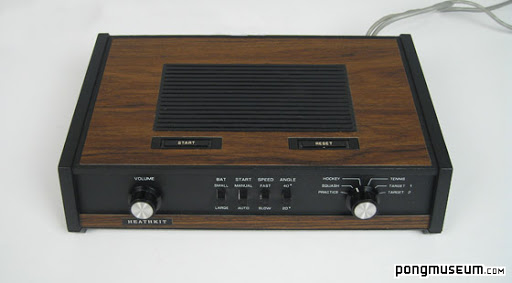-
1976
Hardware Description
Heathkit was a famous kit manufacturer in the 1970s. Their catalog was long: it proposed everything from simple projects to advanced test equipment, color TV sets, Hi-Fi, and of course video games.
The Heathkit GD-1380 kit was released in 1976 and it looks like an old car radio... It plays the six games of the AY-3-8500 chip, and has several interesting features. First, it requires a Heathkit TV set to operate because of its composite output. Back in 1976, only monitors and hi-tech equipment had a composite input. To use this system, the user had to open his TV set in order to connect a few wires to its electronic circuits. This is the case with the Heathkit TV sets: the user manual explains how to connect the system to several TV sets released by Heathkit.
The Lightgun reminds those old laser guns from old TV series. It is quite ergonomic, but uses a simple push-button as trigger. The case is still excellent. The following additional informations about the light gun came from Bill Wilkinson:
"If I remember right, one of those two (Heathkit Pong) models was a shoot-em-up type game where you aimed a "gun" at the TV set, pulled the trigger, and the screen would indicate a hit or miss. Possibly to save on design budget, the gun case was from a strobe light used in one of their automotive timing light kits. Heath Company used that case for most of their automotive kits that came with a timing light. The CO-2500 and CI-1040 come to mind."
The system has another interesting feature: the sound does not come from the system itself like most of the other PONG consoles, but comes from the TV set. The main reason for this is the direct connexion of the system to the TV set. Since the TV had to be open for connecting, why not connecting additional wires to the audio amplifier of the TV instead of using a speaker in the system ? Using the TV as audio output was not possible with regular systems which used a video modulator. Outputing the sound to the TV would have required additional circuits, hence a higher price of the systems. Here, the system benefits of a direct connexion to the TV set, hence the possibility of using the audio circuits of the TV without additional costs. A last thing: the blue electronic gun of the system is very funny, and the user manual is extremely detailed.
-
Model Number:
GD-1380 -
Manufacturer:
-
Hardware Type:
Video Game -
Manufacture Year:
1976 -
More Info:
-
We recognize our sponsors starting at $1 per entry.
Learn more at https://www.ithistory.org/benefits

